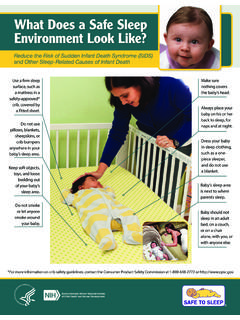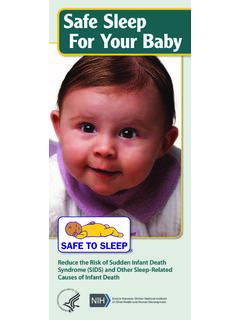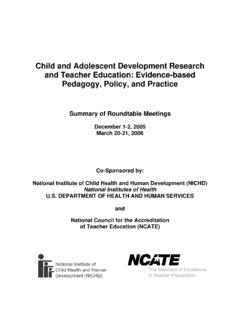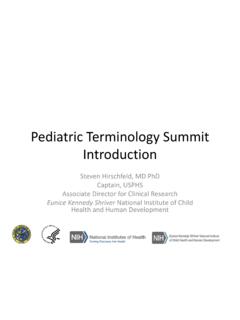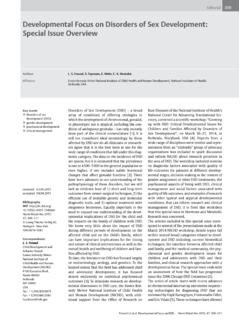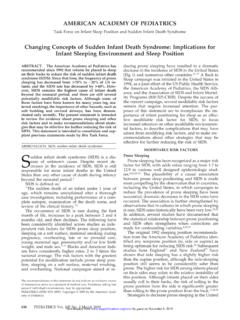Transcription of Targeting Sudden Infant Death - nichd.nih.gov
1 FROM CELLS TO SELVES Targeting Sudden Infant Death syndrome (SIDS): A Strategic Plan National Institute of Child Health and Human Development FROM CELLS TO SELVES Targeting Sudden Infant Death syndrome (SIDS): A Strategic Plan Contents The NICHD Mission .. 1 The Strategic Planning Process .. 3 Introduction .. 5 Etiology and Pathogenesis .. 6 Prognostics and Diagnostics .. 7 Preventive Strategies .. 7 Health Disparities .. 7 The Concept of Risk in SIDS Research .. 8 Etiology and Pathogenesis .. 9 The Brain and Homeostatic Control .. 10 Autonomic Development and Function .. 12 Infant Care and the Sleep Environment .. 14 Infectious Disease and Immunity.
2 16 Genetics .. 17 Sudden and Unexpected Death in Childhood .. 19 Infrastructure: DNA and Tissue Banks .. 20 Prognostics and Diagnostics .. 21 Preventive Strategies .. 25 Research .. 26 Interventions .. 29 Infrastructure .. 31 Health Disparities .. 33 Research .. 35 Interventions .. 36 Infrastructure .. 37 Appendix Roster of Advisors .. 39 iii FROM CELLS TO SELVES Targeting Sudden Infant Death syndrome (SIDS): A Strategic Plan The NICHD Mission The National Institute of Child Health and Human Development (NICHD) seeks to ensure that every individual is born healthy, is born wanted, and has the opportunity to fulfill his or her potential for a productive life unhampered by disease or disability.
3 The Institute further strives to help parents have the children they want, at the times they want them, and to ensure that every mother experiences a pregnancy free of adverse complications, and that persons with physical or mental disabilities receive the maximum benefit of rehabilitation to allow them to function as fully as possible in society. Key to the success of this mission is answering the fundamental questions of how a single fertilized cell eventually develops into a fully functional adult human being and how a multitude of genetic and environmental factors influence that process for good or ill. Programs at the NICHD are based on the concepts that adult health and well-being are determined in large part by episodes early in life, sometimes before birth; that human development is continuous throughout life; and that optimal outcomes of development are important not only to the individual but to society.
4 NICHD research is also directed toward restoring or maximizing individual potential and functional capacity when disease, injury, or a chronic disorder intervenes in the developmental process. Thus, the NICHD mission truly spans the life cycle, and much of the health and well-being of our population depends on the success of the Institute s research. 1 FROM CELLS TO SEL VES Targeting Sudden Infant Death syndrome (SIDS): A Strategic Plan The Strategic Planning Process During 1998 and 1999, the NICHD staff engaged the scientific community in jointly developing a strategic plan to facilitate achieving its mission. The initial framework document for this plan, From Cells to Selves, highlighted four areas for immediate strategic development and described a series of scientific goals under each area.
5 These four areas were as follows: Genetics and Fetal Antecedents of Disease Susceptibility includes the interaction of the genotype with socioeconomic, environmental, and psychological factors in the fetal and postnatal environment that contribute to health or the pathophysiology of diseases. Reproductive Health for the 21st Century comprises the biological and behavioral factors that allow couples to have healthy children when they want them and the reproduction-related conditions that may affect women during and after their reproductive years. Developmental Biology: Understanding Normal and Abnormal Development consists of the basic biological science necessary to understand early development in utero and through the time when many organ systems form.
6 Biobehavioral Development includes research to better understand the developmental processes involved in forming cognitive, learning, emotional, social, and physical behaviors, and the biological and environmental factors that make infants, children, and adolescents more susceptible to behavioral disorders or to adopting risk-taking and violent behaviors. Health Disparities: Bridging the Gap, a fifth strategic plan, was developed to better understand how natural biological and behavioral forces interact with a variety of social, community, and economic factors to produce health disparities, and how to intervene to enhance the health and well-being of these minority and underserved populations. In addition, at the request of the United States Congress, the NICHD produced strategic plans in 1989 and 1995 that summarized advances in Sudden Infant Death syndrome (SIDS) research and made recommendations identifying the most promising avenues of research to be pursued over subsequent 5-year periods.
7 In 1999, Congress recommended that the Institute develop a third 5-year plan. Since the NICHD has been engaged in strategic planning from 1998 to 2001, the planning process for the SIDS program was integrated with the development of other research agendas. To formulate the new SIDS strategic plan, the NICHD convened a working group comprising distinguished scientists and health care professionals from around the country. (See Appendix.) In collaboration with NICHD staff, the working group identified and prioritized research goals and suggested strategies to meet those goals. The working group drew upon ongoing planning efforts, previous emphasis areas, recent forums, workshops, conferences, and research findings to develop a draft of the strategic plan for a SIDS research and public health agenda that would guide the Institute for the next 5 years.
8 3 FROM CELLS TO SELVES Targeting Sudden Infant Death syndrome (SIDS): A Strategic Plan The draft plan was posted on the NICHD Web site to allow members of advocacy groups, nonprofit organizations, the scientific community, and the general public to comment. In addition, the Institute shared the plan with members of the National Advisory Child Health and Human Development Council and with the Friends of the NICHD, a coalition of more than 100 professional and patient organizations committed to the Institute s scientific mission. After consolidating and reviewing all comments, the NICHD revised and finalized the plan. This document is intended as a targeted, but flexible, blueprint that can be modified as new scientific findings, research opportunities, or resources become available.
9 4 FROM CELLS TO SELVES Targeting Sudden Infant Death syndrome (SIDS): A Strategic Plan Introduction SIDS occurs worldwide. In the United States alone, approximately 3,000 infants die each year from SIDS. The majority of SIDS deaths occur before infants reach 6 months of age. These deaths, although associated with a sleep period, are Sudden and unpredictable. In most cases, infants appear healthy before succumbing to SIDS. No explanation for these deaths can be found, even when a complete postmortem is performed, including an autopsy, an examination of the Death scene, and a review of the Infant s clinical and family history. In the absence of an identifiable cause of Death , these infants deaths are, by standard definition, labeled SIDS.
10 SIDS exacts a devastating emotional toll on affected families and caregivers. In 1974, landmark legislation the Sudden Infant Death syndrome Act ( 93-270) gave the NICHD the statutory responsibility to oversee SIDS research. The Institute s ultimate goal is to eliminate SIDS. To reach this aim, it is important to understand the underlying causes and mechanisms of the syndrome , to develop strategies to identify infants at high risk for Sudden Death , and to develop and implement preventive strategies that can effectively reduce the incidence of SIDS across diverse populations. Great progress has been achieved in understanding SIDS and reducing the number of deaths caused by this tragic disorder since the formulation of the first 5-year plan.

